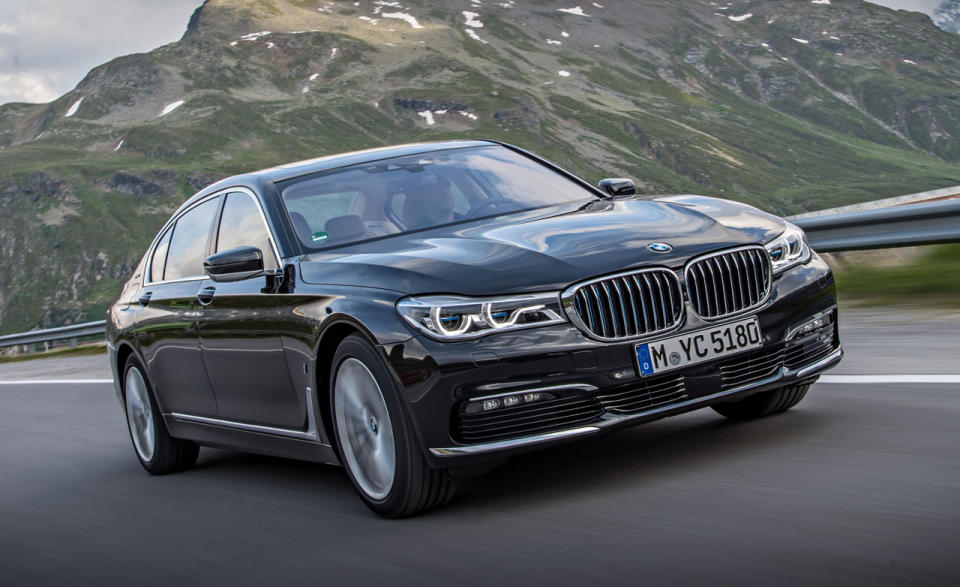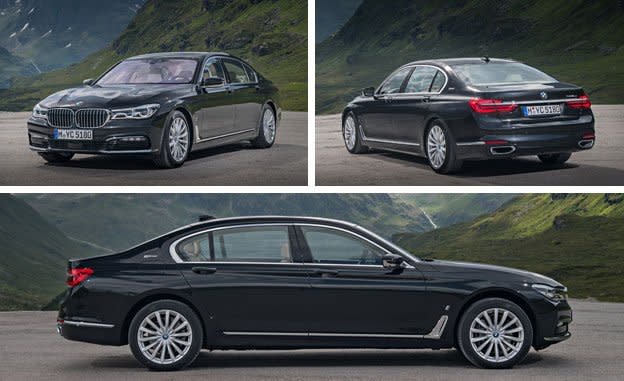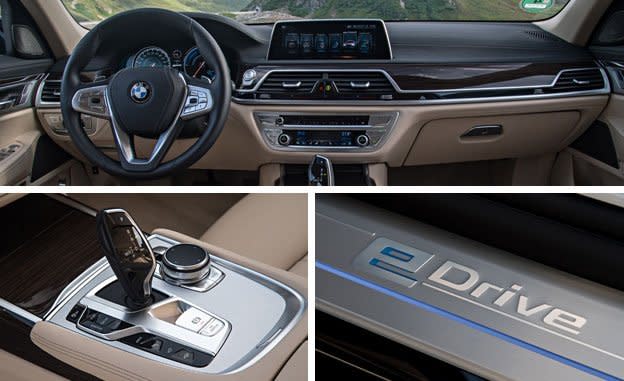2017 BMW 740e xDrive Plug-In Hybrid

Regulators have left carmakers little choice but to embrace plug-in-hybrid technology: In Europe, for example, ultra-aggressive fuel-consumption standards, coupled with testing methods heavily favoring plug-ins, give such models a big advantage. In China, they’re favored by legislation at both the municipal and national levels. Here in the U.S., CAFE requirements, environmental concerns, and more are putting pressure on manufacturers to pursue alternatives to conventional powertrains. Sales of reasonably priced plug-ins have begun to increase globally—especially in China—but sales of premium hybrids typically have been abysmal. Witness BMW’s struggles with its ActiveHybrid line of vehicles, most of which have been discontinued.
Yet BMW is not giving up. Meet the company’s latest attempt to appeal to premium shoppers with an eco bent: the 740e xDrive. We drove the car at the 2016 Silvretta E-Car Rallye in Austria, an electric- and hybrid-vehicle offshoot of the Silvretta Classic Rallye for vintage cars.
First-Ever Four-Cylinder 7-series
The 740e is powered in part by the same 2.0-liter turbocharged four-cylinder gasoline engine that is offered in other BMWs, with help from an electric motor. It’s notable for being the first-ever four-banger in a 7-series for the American market; other markets will soon get a 730i with a gasoline 2.0-liter turbo. While putting such a tiny engine in the large 7-series sedan doesn't sound like it would work well, this powertrain actually provides surprisingly good performance.
Credit turbocharging and electrification. The gasoline engine produces just 255 horsepower on its own, but the electric motor can add 111 horsepower. Maximum total system output stands at 322 horsepower at 4600 rpm, while maximum torque is 369 lb-ft and is available from 1250 to 4600 rpm.

That's enough for a zero-to-60-mph sprint of an estimated 5.2 seconds and a terminal velocity of 155 mph. The power comes on quietly and is channeled via xDrive all-wheel drive through the familiar ZF-sourced eight-speed automatic; gearchanges are buttery smooth, and there is always traction to be found, even on wet surfaces. The hybrid powertrain can be switched among several modes, including EV only, battery hold (which saves juice for when the driver needs it), battery charge, and normal hybrid operation. (The car also offers a Sport mode, which sharpens throttle response as well as the chassis, something the other modes don’t affect.) In the 740e’s battery-charging drive mode, drivers can select the level of charge they’d like the car to reach—say, 70 percent—and the engine will recharge it to that level before switching to battery-hold mode. With a full charge and in EV mode, the 740e can go up to 28 miles on electricity only, BMW says. What's not to like?
Well, that depends on what you expect from a BMW. The 740e is a competent machine, and it performs the tasks it's asked to carry out without complaining, namely transporting up to five people in absolute luxury and comfort. But it does so with no semblance of enthusiasm. Yes, step-off is impressive, and the 740e’s electric motor can help deliver sudden bursts of acceleration when your right foot asks. On the other hand, there is no mistaking its engine for anything other than the four-banger it is: While well behaved at low rpm, it never sounds good, its aural character a sort of muffled drone as you wind up the tachometer. It’s never loud or intrusive, but it doesn't come close to delivering the smoothness and refinement of BMW's traditional inline-six engines. And as you build up to freeway velocities (and beyond), the electric boost withers away, and you end up moving a massive car with a tiny engine. In fact, the 740e is the heaviest 7-series BMW makes.
You will especially notice this weight when you choose EV mode. That's a decision that cannot be taken lightly (zing!) as it amounts to an exercise in asceticism that the long line of cars trapped behind you likely will fail to appreciate. Acceleration is leisurely at best, and the internal-combustion engine ignites at 87 mph, a speed that can be sustained for only a few minutes in EV mode anyway.
Not Particularly Efficient
What's more, the 740e didn't come close to the promised fuel-economy ratings in our drive, at least according to the car’s trip computer. It is rated at 112 mpg in the utterly meaningless European-market cycle for plug-in hybrids. Here's our experience: We started out with a full tank of gas and a fully charged battery. But even before we embarked on our drive through Austria's Montafon mountains, we managed to reduce the vehicle's electric range from 28 to 22 miles by idling for 15 minutes as we examined the car’s interior, and it took only six over-the-road, uphill miles to diminish electric range to a sorry five miles. Without an electric aid for much of our drive, then, the four-cylinder engine displayed a healthy appetite for fuel, and an indicated 20.3 mpg is all we managed to squeeze out of it by the end of the day. It is worth noting that we spent some time in the battery-charge mode, although we never fully rejuiced the 9.2-kWh pack.
A diesel, we dare say, would have used a lot less fuel over that distance, and we doubt that a 740i, with its silky-smooth inline-six, would have fared much worse than this plug-in hybrid, even taking into account the mountainous route. (Our long-term 740i, for example, is averaging 26 mpg through 7000 miles.) Unless you have a very short commute—over flat terrain—and the ability to recharge your car in your parking spot, you likely won't be able to lower your fuel bill by any meaningful amount without constantly feather-footing the car. In addition, we suspect that a lot of owners of plug-in hybrids won't regularly plug in their cars, instead opting to recharge their batteries with the four-cylinder engine under the hood. This, of course, is the least efficient way to recharge the battery pack, although depending on your regional power grid, it may not necessarily be the dirtiest.
Handling the Extra Weight
As with all 7-series models, the plug-in rides very well, offering supple comfort during cruising, and it makes a wonderful long-haul companion. But when pushed on twisty roads, it becomes obvious that the 740e lacks some of the agility displayed by its conventionally powered siblings, a result of the heavy lithium-ion high-voltage battery pack. The car turns in nicely, but you can feel the standard air suspension working hard in corners to corral the additional pounds in an attempt to maintain a flat attitude. It’s only partly successful, as our first exposure seemed to indicate the car has more body roll than other 7-series models we’ve driven. The brakes are strong, but they feel slightly spongy, and BMW has yet to fully master the transition between regenerative and friction braking. That said, they’re good for a plug-in hybrid, and most drivers won’t notice the difference. Add to this an engine that sounds overtaxed—even if it isn’t—and the car simply feels unexcited about driving quickly.

Inside, the 740e is finished as splendidly as you’d expect of a flagship, with wood and leather and other finery sprinkled throughout. The rear seat offers plenty of space—when the car arrives in the United States this fall, it will be offered only in long-wheelbase form—and BMW plans to offer a long list of infotainment and telematics options to delight all occupants. The only demerit we could find with the interior (besides the silly gesture controls you’ll never use) is that the battery pack eats into the trunk space, reducing it from roughly 18 cubic feet in a regular model to approximately 15 here. For 2017, BMW will finally offer Americans its remote-parking technology, with which an owner can park the car from outside—except on the 740e. That makes no sense to us; don’t electrified mobility and autonomous driving go hand in hand? In any case, the 740e xDrive gets a plethora of blue accents and badges inside and out that underscore its family ties with the i3 and the i8.
Priced at $90,095, the 740e xDrive slots neatly between the $82,295 740i xDrive and the $98,595 750i xDrive. Americans will be able to order the 740e only with all-wheel drive. The six- and eight-cylinder versions of the 7-series, by contrast, can be spec’d with rear-wheel drive, shaving $2800 and $3000 from their retail prices.
As unengaging as the 740e xDrive is to drive, it is competent, comfortable, and fast, and its well-sorted powertrain performs flawlessly as long as you don’t expect sky-high fuel economy. We were certainly hoping the car would deliver the excitement promised by its BMW roundel, but if regulation eventually leaves us no choice, this is a future we could live with.
Specifications >
VEHICLE TYPE: front-engine, 4-wheel-drive, 5-passenger, 4-door sedan
BASE PRICE: $90,095
ENGINE TYPE: turbocharged and intercooled DOHC 16-valve 2.0-liter inline-4, 255 hp, 295 lb-ft; permanent-magnet synchronous AC electric motor, 111 hp, 184 lb-ft; combined power rating, 322 hp, 369 lb-ft; 9.2-kWh lithium-ion battery pack
TRANSMISSION: 8-speed automatic with manual shifting mode
DIMENSIONS:
Wheelbase: 126.4 in
Length: 206.2 in
Width: 74.9 in Height: 58.2 in
Cargo volume: 15 cu ft
Curb weight (C/D est): 4700 lb
PERFORMANCE (C/D EST):
Zero to 60 mph: 5.3 sec
Zero to 100 mph: 12.3 sec
Standing ¼-mile: 13.8 sec
Top speed: 155 mph
FUEL ECONOMY (C/D EST):
EPA city/highway: 24/34 MPGe (battery depleted); 64/75 MPGe (battery charged)

 Yahoo Autos
Yahoo Autos 